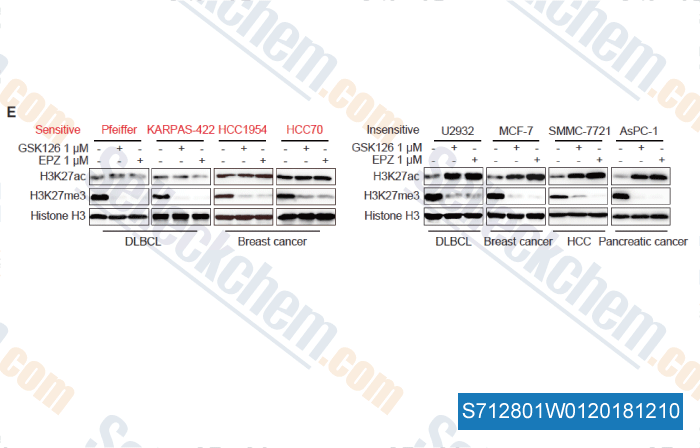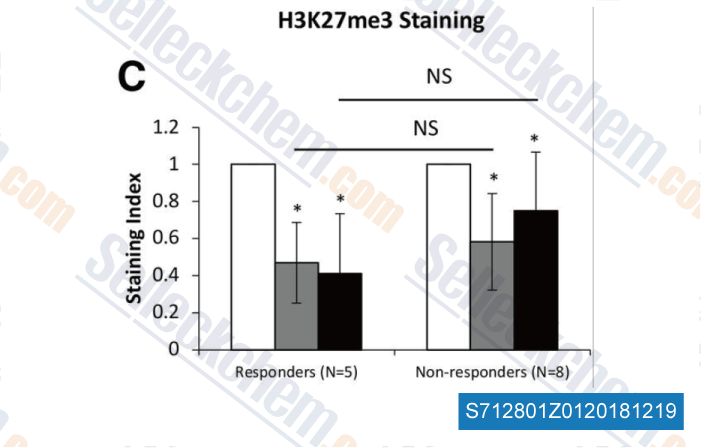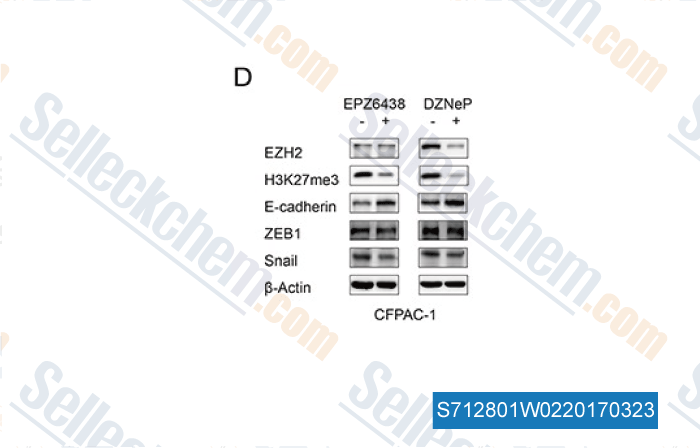|
Toll Free: (877) 796-6397 -- USA and Canada only -- |
Fax: +1-832-582-8590 Orders: +1-832-582-8158 |
Tech Support: +1-832-582-8158 Ext:3 Please provide your Order Number in the email. |
Technical Data
| Formula | C34H44N4O4 |
|||
| Molecular Weight | 572.74 | CAS No. | 1403254-99-8 | |
| Solubility (25°C)* | In vitro | DMSO | 100 mg/mL (174.59 mM) | |
| Water | Insoluble | |||
| Ethanol | Insoluble | |||
|
* <1 mg/ml means slightly soluble or insoluble. * Please note that Selleck tests the solubility of all compounds in-house, and the actual solubility may differ slightly from published values. This is normal and is due to slight batch-to-batch variations. * Room temperature shipping (Stability testing shows this product can be shipped without any cooling measures.) |
||||
Preparing Stock Solutions
Biological Activity
| Description | Tazemetostat (EPZ-6438, E7438) is a potent, and selective EZH2 inhibitor with Ki and IC50 of 2.5 nM and 11 nM in cell-free assays, exhibiting a 35-fold selectivity versus EZH1 and >4,500-fold selectivity relative to 14 other HMTs. | ||
|---|---|---|---|
| Targets |
|
||
| In vitro | EPZ-6438 concentration-dependently reduces global H3K27Me3 levels in wild-type or SMARCB1 mutant cells, and induces strong antiproliferative effects with IC50 ranging from 32 nM to 1000 nM in SMARCB1-deleted MRT cell lines. EPZ-6438 induces gene expression of neuronal differentiation and cell cycle inhibition, while inhibtis expression of Hedgehog pathway genes, MYC and EZH2. [1] The antiproliferative effect of EPZ-6438 is enhanced by either prednisolone or dexamethasone in several EZH2 mutant lymphoma cell lines. [2] | ||
| In vivo | In SCID mice bearing s.c. G401 xenografts, EPZ-6438 induces tumor stasis during the administration period and produces a significant tumor growth delay with minimal effect on body weight. [1] | ||
| Features | Orally bioavailable EZH2-selective inhibitor for both wild-type and mutant. Currently being tested in Phase II clinical trials for treatment of Diffuse Large B Cell Lymphoma. |
Protocol (from reference)
| Kinase Assay:[1] |
|
|---|---|
| Cell Assay:[1] |
|
| Animal Study:[1] |
|
References
|
Customer Product Validation

-
Data from [Data independently produced by , , Cell, 2018, 175(1):186-199]

-
Data from [Data independently produced by , , J Pathol, 2017, 242(3):371-383]

-
Data from [Data independently produced by , , Clin Epigenetics, 2018, 10(1):121]

-
Data from [Data independently produced by , , Oncotarget, 2016, 7(10):11194-207]
Selleck's Tazemetostat (EPZ-6438) has been cited by 135 publications
| EZH2 inhibitors promote β-like cell regeneration in young and adult type 1 diabetes donors [ Signal Transduct Target Ther, 2024, 9(1):2] | PubMed: 38161208 |
| Epigenetic regulation of CD38/CD48 by KDM6A mediates NK cell response in multiple myeloma [ Nat Commun, 2024, 15(1):1367] | PubMed: 38355622 |
| C-terminal binding protein (CTBP2) is a novel tumor suppressor targeting the MYC-IRF4 axis in multiple myeloma [ Blood Adv, 2024, bloodadvances.2023010218] | PubMed: 38457926 |
| Inhibition of epigenetic and cell cycle-related targets in glioblastoma cell lines reveals that onametostat reduces proliferation and viability in both normoxic and hypoxic conditions [ Sci Rep, 2024, 14(1):4303] | PubMed: 38383756 |
| Select EZH2 inhibitors enhance viral mimicry effects of DNMT inhibition through a mechanism involving NFAT:AP-1 signaling [ Sci Adv, 2024, 10(13):eadk4423] | PubMed: 38536911 |
| NSD2 is a requisite subunit of the AR/FOXA1 neo-enhanceosome in promoting prostate tumorigenesis [ bioRxiv, 2024, 2024.02.22.581560] | PubMed: 38464251 |
| EZH2 mediated metabolic rewiring promotes tumor growth independently of histone methyltransferase activity in ovarian cancer [ Mol Cancer, 2023, 22(1):85] | PubMed: 37210576 |
| PRC2.1- and PRC2.2-specific accessory proteins drive recruitment of different forms of canonical PRC1 [ Mol Cell, 2023, 83(9):1393-1411.e7] | PubMed: 37030288 |
| EZH2 inhibition stimulates repetitive element expression and viral mimicry in resting splenic B cells [ EMBO J, 2023, 10.15252/embj.2023114462] | PubMed: 37934086 |
| Polycomb repressor complex 2 suppresses interferon-responsive MHC-II expression in melanoma cells and is associated with anti-PD-1 resistance [ J Immunother Cancer, 2023, 11(11)e007736] | PubMed: 38315170 |
RETURN POLICY
Selleck Chemical’s Unconditional Return Policy ensures a smooth online shopping experience for our customers. If you are in any way unsatisfied with your purchase, you may return any item(s) within 7 days of receiving it. In the event of product quality issues, either protocol related or product related problems, you may return any item(s) within 365 days from the original purchase date. Please follow the instructions below when returning products.
SHIPPING AND STORAGE
Selleck products are transported at room temperature. If you receive the product at room temperature, please rest assured, the Selleck Quality Inspection Department has conducted experiments to verify that the normal temperature placement of one month will not affect the biological activity of powder products. After collecting, please store the product according to the requirements described in the datasheet. Most Selleck products are stable under the recommended conditions.
NOT FOR HUMAN, VETERINARY DIAGNOSTIC OR THERAPEUTIC USE.
